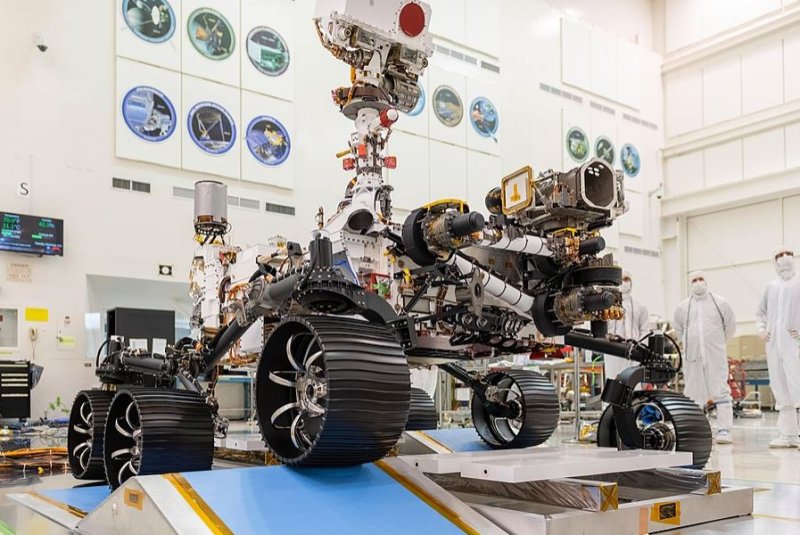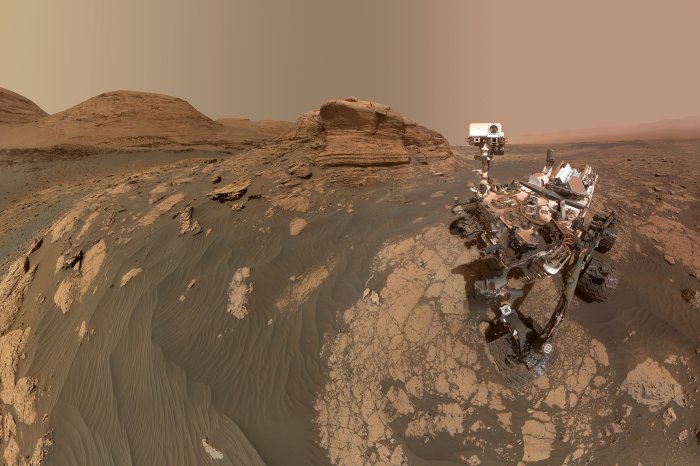In a clean room at NASA's Jet Propulsion Laboratory in Pasadena, Calif., engineers observe the first driving test for NASA's Perseverance rover in December. File Photo courtesy of NASA
July 20 (UPI) -- NASA engineers are counting on a blend of old and new technology to get the Mars 2020 spacecraft and Perseverance rover to the surface of the Red Planet. But if they don't launch by mid-August, the mission will be delayed for more than two years.
Already postponed twice, Mars 2020 is scheduled to launch no sooner than July 30. Its launch window -- allowing it to intercept the path of Mars -- runs through Aug. 15.
"The period where Earth and Mars are on the same side of the sun, or in opposition, is about once every 26 months," Ray Baker, an engineer at NASA's Jet Propulsion Laboratory and flight systems manager for the Mars 2020 mission, told UPI.
At present, Mars and Earth aren't in opposition, but they will be come this fall.
"If you were playing soccer and passing a ball to a teammate who is running full speed down the sideline, you kick the ball to where the player is going to be, not where the player is right then," Baker said.
In other words, NASA must launch Mars 2020 very soon so that the spacecraft will swing into the Red Planet's orbit when Earth and Mars are closer together.
But timing isn't the only thing on the minds of NASA's flight engineers.
Leaving Earth
Before the mission's science team can collect data, the Mars 2020 spacecraft must make it past Earth's gravity, traverse 76 million miles of interplanetary space and land safely inside the Red Planet's Jezero Crater, a region that features tremendous geologic diversity.
To start, Mars 2020 will use on the powerful thrust of an Atlas V-541 rocket, launched from Kennedy Space Center in Florida, to escape Earth's gravity. After the rocket carries Mars 2020 into space, the craft will take a wide orbit around Earth before swinging toward Mars.
The spacecraft consists of three main components: the cruise stage; the entry, descent and landing system; and the rover. During the six-month cruise stage, the spacecraft will use its thrusters to maintain proper speeds and the correct path toward Mars.
Arrival in Mars orbit
Once in orbit around the Red Planet, the spacecraft will utilize its entry, descent and landing system, which features an aeroshell, parachute, descent vehicle and crane-like contraption that will free the rover to roam the Martian surface.
Managing the entry, descent and landing system, or EDL, is a stressful job.
"It's a very challenging phase of the mission. It leaves zero room for error," Baker said. In "a lot of the systems designed for EDL, we're not able to build in redundancy. There are a large number of what are called single-string events that have to happen for the entry, descent and landing to be successful."
Many of the systems and much of the technology that Mars 2020 will use for EDL are called legacy technologies. They've been used successfully in previous Mars missions, but engineers have made updates.
"Our parachute has been strengthened," Baker said. "We're very confident that that parachute is robust and going to do its job."
Engineers also updated the trigger for the parachute. Previous Mars missions have relied on a velocity trigger for parachute deployment.
"On 2020, we'll use [a velocity trigger] plus a range trigger, which is our estimated distance to the landing site," Baker said. "That allows us to really shrink down our landing eclipse."
The landing zone for the Curiosity rover, for example, was roughly 12.5 miles by 4 miles.
"Our ellipse is 7.5 kilometers by 6 kilometers [4.5 miles by 4 miles] -- almost circular," Baker said. "That allows us to go to a landing site that is more challenging. We can tuck that circle into mountains and craters."
Surface landing
After the descent vehicle is released and the parachute is deploys, cameras will snap pictures of the terrain and compare them to a map compiled by NASA spacecraft already in orbit around Mars. The mapping systems will help the spacecraft hone in on its landing spot.
The spacecraft's ability to compare its trajectory to programmed maps in real time is the update Baker said he is most excited about.
Once on the ground, a contraption called the Sky Crane will lift and safely swivel the frame of the descent vehicle away from the Perseverance rover.
And finally, after a series of system checks, the rover will begin its science mission -- 203 days after it launched from Earth.
First flight on Mars
Though the Perseverance rover and its suite of scientific instruments are mostly interested in the Martian surface, the rocks and soil found in Jezero Crater, the Mars 2020 mission won't be relegated to the ground.
Next year, scientists will test a miniature helicopter on Mars, the first time controlled flight has been attempted on another planet. NASA engineers built the novel drone, named Ingenuity, to withstand extremely cold temperatures and remain airborne in the ultra-thin Martian atmosphere.
The helicopter will hover using two rotors with carbon-fiber blades, each spinning in opposite directions at speeds of 2,400 rotations per minute. A camera will allow the helicopter to document the terrain on its short test flights.
Researchers aren't counting on Ingenuity to conduct the Mars 2020 science mission. Instead, engineers are simply looking to test the drone's novel technologies -- technologies that could be used to empower a more sophisticated aerial mission on future trips.
NASA’s Curiosity Mars rover used two different cameras to create this panoramic selfie, comprised of 60 images, in front of Mont Mercou, a rock outcrop that stands 20 feet tall on March 26, 2021, the 3,070th Martian day, or sol, of the mission. These were combined with 11 images taken by the Mastcam on the mast, or "head," of the rover on March 16. The hole visible to the left of the rover is where its robotic drill sampled a rock nicknamed "Nontron." The Curiosity team is nicknaming features in this part of Mars using names from the region around the village of Nontron in southwestern France. Photo courtesy of NASA/JPL-Caltech/MSSS
















